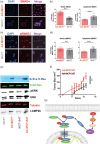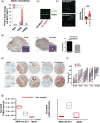Collagen production and niche engineering: A novel strategy for cancer cells to survive acidosis in DCIS and evolve
- PMID: 33294017
- PMCID: PMC7691473
- DOI: 10.1111/eva.13075
Collagen production and niche engineering: A novel strategy for cancer cells to survive acidosis in DCIS and evolve
Abstract
Growing tumors are dynamic and nonlinear ecosystems, wherein cancer cells adapt to their local microenvironment, and these adaptations further modify the environment, inducing more changes. From nascent intraductal neoplasms to disseminated metastatic disease, several levels of evolutionary adaptations and selections occur. Here, we focus on one example of such an adaptation mechanism, namely, "niche construction" promoted by adaptation to acidosis, which is a metabolic adaptation to the early harsh environment in intraductal neoplasms. The avascular characteristics of ductal carcinoma in situ (DCIS) make the periluminal volume profoundly acidic, and cancer cells must adapt to this to survive. Based on discovery proteomics, we hypothesized that a component of acid adaptation involves production of collagen by pre-cancer cells that remodels the extracellular matrix (ECM) and stabilizes cells under acid stress. The proteomic data were surprising as collagen production and deposition are commonly believed to be the responsibility of mesenchymally derived fibroblasts, and not cells of epithelial origin. Subsequent experiments in 3D culture, spinning disk and second harmonic generation microscopy of DCIS lesions in patients' samples are concordant. Collagen production assay by acid-adapted cells in vitro demonstrated that the mechanism of induction involves the RAS and SMAD pathways. Secretome analyses show upregulation of ECM remodeling enzymes such as TGM2 and LOXL2 that are collagen crosslinkers. These data strongly indicate that acidosis in incipient cancers induces collagen production by cancer cells and support the hypothesis that this adaptation initiates a tumor-permissive microenvironment promoting survival and growth of nascent cancers.
Keywords: K‐RAS; Niche construction and engineering; SMAD; anoikis; cancer evolution; collagen production; extracellular matrix remodeling enzymes; tumor microenvironment.
© 2020 The Authors. Evolutionary Applications published by John Wiley & Sons Ltd.
Conflict of interest statement
The authors declare no competing interests.
Figures





Similar articles
-
Identification of distinct slow mode of reversible adaptation of pancreatic ductal adenocarcinoma to the prolonged acidic pH microenvironment.J Exp Clin Cancer Res. 2022 Apr 11;41(1):137. doi: 10.1186/s13046-022-02329-x. J Exp Clin Cancer Res. 2022. PMID: 35410237 Free PMC article.
-
Establishment of a 3D co-culture model to investigate the role of primary fibroblasts in ductal carcinoma in situ of the breast.Cancer Rep (Hoboken). 2023 Apr;6(4):e1771. doi: 10.1002/cnr2.1771. Epub 2022 Dec 19. Cancer Rep (Hoboken). 2023. PMID: 36534078 Free PMC article.
-
Gene expression profiling of tumour epithelial and stromal compartments during breast cancer progression.Breast Cancer Res Treat. 2012 Aug;135(1):153-65. doi: 10.1007/s10549-012-2123-4. Epub 2012 Jun 21. Breast Cancer Res Treat. 2012. PMID: 22718308
-
Impact of breast cancer cells´ secretome on the brain metastatic niche remodeling.Semin Cancer Biol. 2020 Feb;60:294-301. doi: 10.1016/j.semcancer.2019.10.011. Epub 2019 Nov 9. Semin Cancer Biol. 2020. PMID: 31711993 Review.
-
Extracellular Matrix Alterations in Metastatic Processes.Int J Mol Sci. 2019 Oct 7;20(19):4947. doi: 10.3390/ijms20194947. Int J Mol Sci. 2019. PMID: 31591367 Free PMC article. Review.
Cited by
-
ECM Composition Differentially Regulates Intracellular and Extracellular pH in Normal and Cancer Pancreatic Duct Epithelial Cells.Int J Mol Sci. 2023 Jun 25;24(13):10632. doi: 10.3390/ijms241310632. Int J Mol Sci. 2023. PMID: 37445810 Free PMC article.
-
What do cellular responses to acidity tell us about cancer?Cancer Metastasis Rev. 2021 Dec;40(4):1159-1176. doi: 10.1007/s10555-021-10005-3. Epub 2021 Nov 30. Cancer Metastasis Rev. 2021. PMID: 34850320 Free PMC article. Review.
-
Proton Transport in Cancer Cells: The Role of Carbonic Anhydrases.Int J Mol Sci. 2021 Mar 20;22(6):3171. doi: 10.3390/ijms22063171. Int J Mol Sci. 2021. PMID: 33804674 Free PMC article. Review.
-
Parallel and convergent dynamics in the evolution of primary breast and lung adenocarcinomas.Commun Biol. 2025 May 21;8(1):775. doi: 10.1038/s42003-025-08123-7. Commun Biol. 2025. PMID: 40399443 Free PMC article.
-
Resistance to Gemcitabine in Pancreatic Ductal Adenocarcinoma: A Physiopathologic and Pharmacologic Review.Cancers (Basel). 2022 May 18;14(10):2486. doi: 10.3390/cancers14102486. Cancers (Basel). 2022. PMID: 35626089 Free PMC article. Review.
References
Grants and funding
LinkOut - more resources
Full Text Sources
Miscellaneous

